#QuerySet
Explore tagged Tumblr posts
Text
Mastering Multiple QuerySet Manipulation in Django
Django is a popular web framework that allows you to create dynamic and interactive web applications using Python. Django follows the model-template-views (MTV) pattern, which separates the data, presentation, and logic layers of the application. Django also provides many features such as authentication, security, database management, and admin interface to make web development easier and faster.
0 notes
Text
getting querysets to tell me what’s actually in them feels like trying to get something out of a dogs mouth
2 notes
·
View notes
Text
Top Django Interview Questions and Answers in 2025

Introduction
If you're aiming for a career in web development, you've probably come across Django, and guess what? It's still going strong in 2025. Whether you're a fresh graduate or an experienced developer eyeing a transition, knowing the top Django interview questions and answers will give you a big edge.
From start-ups to the world's biggest social networking site Instagram, this framework has changed things a lot. It's one of the favorites due to its simplicity, security, and scalability. But with the increasing competition, interviewers have started to pick brains. So let us prepare you with some of the most relevant and updated top Django interview questions and answers that you will need for 2025.
Basics of Django
What is Django?
Django is a high-level Python web framework that lets you rapidly develop secure and maintainable web applications with as little coding as possible. Basically, it follows the "batteries-included" philosophy, which states that user authentication, content management, and database administration are included from the start.
Key Features of Django Framework
MTV architecture (Model-Template-View)
ORM (Object-Relational Mapping)
Admin Interface
Built-in security features
Highly scalable and portable
What Are Django’s Advantages over Other Frameworks?
It's Pythonic-clean and easy to read
Fastest development cycle
Rich documentation
Large community
Tons of third-party packages
Django Interview Questions Asked Quite Often (Beginner Level)
Explain MTV Architecture in Django?
MTV stands for:
Model: It defines what the data structure is.
Template: HTML-like design files.
View: Contains business logic that connects the models and templates.
It's like the way Django interprets Model-View-Controller.
How Does a Request in Django Differs from a Response?
Every HTTP request in Django goes through many processes, that are URL dispatcher, view function, and finally returning an HTTPResponse object. It simply can be thought as a pipeline managing routing, logic, and output.
What Are Models in Django?
Models specify the structure of your database in terms of Python classes; they also act as a bridge between the application and the database using Django's ORM.
Intermediate Questions for Django Interviews
How to Differentiate between a Project and an App?
Project: The entire web application.
App: A component or module within a project (eg., blog, cart, and user).
You can plug many apps into one project.
What Are QuerySets, and How Do They Work?
A queryset is a collection of queries that can be executed against a database to retrieve objects. It is lazy — meaning it will not query the database until the results are explicitly requested.
Advanced Questions for Django Interviews
How are Security Issues (XSS, CSRF, etc.) Handled by Django?
Django has built-in protections against:
CSRF tokens in forms
Auto-escaping of templates in XSS
SQL injection with an ORM
Protection against clickjacking by middleware
What Is Middleware in Django?
Middleware is a framework of hooks into Django's request/response processing. It is a light, low-level plugin system for globally altering Django's input or output. For example, it can be useful for:
Logging requests
Modifying responses
Enforcing authentication
What Are Ways to Enhance Django Application Performance?
Use caching (Redis or Memcached).
Optimize QuerySets.
Minimize template logic.
Compress static files.
Use Django Debug Toolbar for diagnosis.
Real-life Scenario Questions
What Will You Do to Scale a Django App under Heavy Load?
Load balancing.
Caching with Redis.
Use CDNs for serving static/media.
Database indexing optimization.
Perform asynchronous tasks with Celery.
How to Connect Django with Frontend Frameworks like React?
Using Django REST Framework for building APIs.
Serve the React app separately or embed it inside templates.
Handle authorization either through JWT or session-based login.
Which Tools Are Used for Testing in Django?
unittest (built-in)
pytest-django
py for test coverage
factory_boy for test data
Tips to Crack Django Interviews
Practice Coding Daily
Even 30 minutes a day adds up so quickly, and try to focus on real-world projects.
Build Real Projects
Nothing beats practical experience. Try to build a blog, an e-commerce site, or a task manager.
Mock Interviews and Technical Tests
Use a platform like Pramp or Interviewing.io to get a feel for what a real interview will be like.
Conclusion
In 2025, mastering the top Django interview questions and answers can be the very key to opening up your way into a development career. Companies have trusted Django for its speed, security, and scalability, and now, being prepared seems to be your golden ticket. Whether you are brushing up or new to the area, this guide will make you succeed.
At TCCI, we don't just teach computers — we build careers. Join us and take the first step toward a brighter future.
Location: Bopal & Iskcon-Ambli in Ahmedabad, Gujarat
Call now on +91 9825618292
Visit Our Website: http://tccicomputercoaching.com/
Note: This Post was originally published on TCCI - Tririd Computer Coaching Institute and is shared here for educational purposes.
#best computer courses in bopal ahmedabad#computer courses near me#software training in Bopal Ahmedabad#TCCI - Tririd Computer Coaching Institute#top Django interview questions and answers
0 notes
Text
Optimize Django QuerySets for High-Performance Applications
Optimizing Django QuerySets for High-Performance Applications 1. Introduction Optimizing Django QuerySets is a critical task for building high-performance web applications. Django’s ORM (Object-Relational Mapping) system provides a powerful and intuitive way to interact with databases, but inefficient use of QuerySets can lead to slow query execution, high memory usage, and poor application…
0 notes
Text
Building RESTful APIs with Python and Flask/Django

RESTful APIs (Representational State Transfer) allow applications to communicate over HTTP, making them essential for modern web and mobile applications.
Python provides two popular frameworks for building REST APIs: Flask (lightweight and flexible) and Django REST Framework (DRF) (powerful and feature-rich).
1. Building a REST API with Flask
Installing Flask and Flask-RESTful
bashpip install flask flask-restful
Creating a Simple Flask REST API
pythonfrom flask import Flask, request, jsonify from flask_restful import Api, Resourceapp = Flask(__name__) api = Api(app)class HelloWorld(Resource): def get(self): return {"message": "Hello, World!"}api.add_resource(HelloWorld, "/")if __name__ == "__main__": app.run(debug=True)
Flask Key Features for REST APIs
Minimal setup with flexible architecture.
Supports JSON responses out-of-the-box.
Works well with SQLAlchemy for database integration.
2. Building a REST API with Django REST Framework (DRF)
Installing Django and DRF
bashpip install django djangorestframewor
Setting Up a Django REST API
Create a Django Project
bash
django-admin startproject myapi cd myapi
Create an App
bash
python manage.py startapp api
Define a Model (models.py)
python
from django.db import models class Item(models.Model): name = models.CharField(max_length=255) description = models.TextField()
Create a Serializer (serializers.py)
python
from rest_framework import serializers from .models import Item class ItemSerializer(serializers.ModelSerializer): class Meta: model = Item fields = '__all__'
Create a View (views.py)
python
from rest_framework import generics from .models import Item from .serializers import ItemSerializer class ItemListCreate(generics.ListCreateAPIView): queryset = Item.objects.all() serializer_class = ItemSerializer
Define URL Patterns (urls.py)
python
from django.urls import path from .views import ItemListCreate urlpatterns = [ path('items/', ItemListCreate.as_view(), name='item-list'),
Run the Server
bash
python manage.py runserver
Django REST Framework Key Features
Built-in authentication and permissions.
Powerful serialization and deserialization.
Browsable API for quick testing.
Choosing Between Flask and Django REST Framework

WEBSITE: https://www.ficusoft.in/python-training-in-chennai/
0 notes
Video
youtube
How to order a QuerySet in descending for date field in django?
0 notes
Text
custom managers 101
Basic usage:
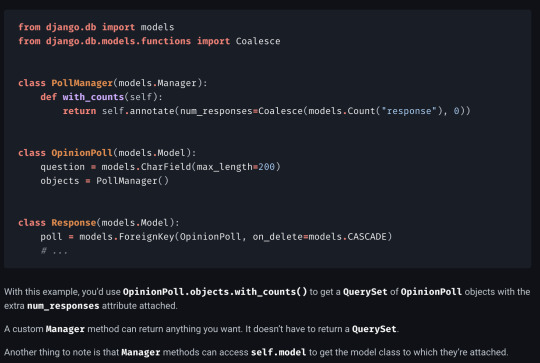
managers are like helper methods for querysets
PollManager.objects.with_counts() prevents you from having to re-write .annotate(...) everywhere
you need to set objects = PollManager() in the Model class
Advanced Usage:
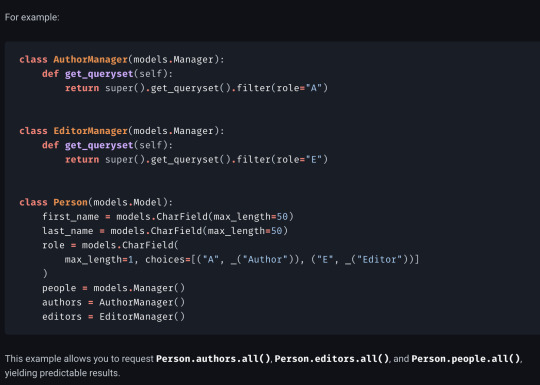
You can also
add more than 1 manager to a model
override the default .all() method
by adding authors = AuthorManager() in the Model class, and defining get_queryset() in the Manager class, you can call Person.authors.all() to get all People objects where role = "A"
Tips:
you can access the original Model in the Manager class by using self.model
don't use __getattr__ because it /can/ prevent managers from being shallow-copied (see here)
don't touch Model._base_manager or Model._default_manager if you're starting out (see here and here)
Links:
https://docs.djangoproject.com/en/4.2/topics/db/managers/
0 notes
Text
0 notes
Photo

Creating views and templates in Django In our next post at www.codesnnippets.com we will be taking a look at how views,models, and urls work together to send and bring data to the templates. It's an amazing framework once you understand how the middle ware bring all the pieces together to craft elegant applications with the beautiful Python syntax. #python #pythonframework #django #web #webdevelopment #djangoviews #djangomodel #djangourls #djangoORM #djangotemplates #querysets https://www.instagram.com/p/CTiGMTRDJwg/?utm_medium=tumblr
#python#pythonframework#django#web#webdevelopment#djangoviews#djangomodel#djangourls#djangoorm#djangotemplates#querysets
0 notes
Text
Django3.0 正式 Release
Django 3.0 在 2019/12/02 正式釋出,
發布了許多新功能以外,
對於舊有的 Python 2 也不予支持,
當然第三方的支持還是能用的,
需要更詳細的 release note 可到官方網站觀看
此處僅列出幾個要點。
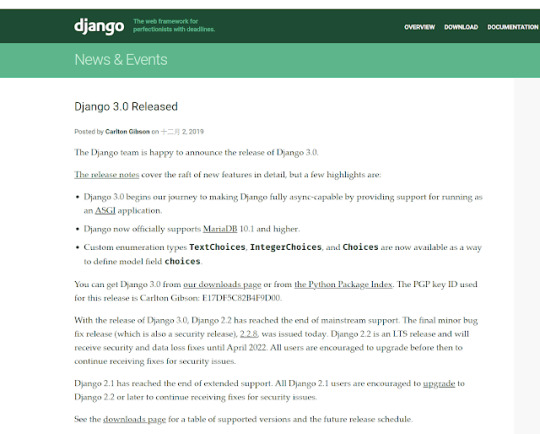
而官方網站也同時釋出了 Django 2.2.8 ,
此版本同時也是 Django 2.2 的最後錯誤修正版本
底下為官方釋出的更新時程表:
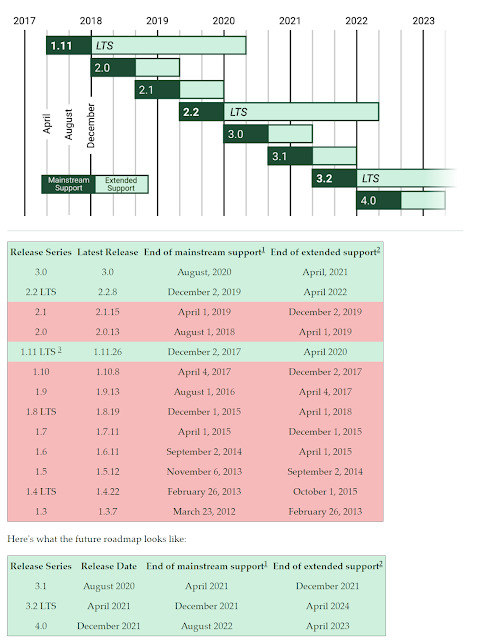
Django 3.0 的主要變更有:
對 ASGI 的支持讓 Djano 具有完整的異步功能
正式支援 MariaDB 10.1 及更新版本
輸出BooleanField的表達式,可以直接在QuerySet過濾器中使用
次要的變更:
django.contrib.admin:
在…
View On WordPress
#ASGI 的支持#BooleanField#Django 3釋出#Django3 release#HTML autocomplete#REQUIRED_FIELDS#X_FRAME_OPTIONS#正式支援 MariaDB#異步功能#直接在QuerySet過濾器中使用
0 notes
Text
Mastering Django QuerySets for Efficient Data Management
Effective Use of Django QuerySets in Data-Driven Applications =========================================================== Introduction Django QuerySets are a powerful and flexible way to interact with database data in Django applications. They provide a high-level interface for performing complex database queries without the need for raw SQL. Effective use of QuerySets is crucial for building…
0 notes
Text
Django meets GraphQL: A Powerful Combination

Assumption:
I’m assuming that y’all have some basic knowledge about Graphql & Django.
If not then kindly go through below link:
Graphql: https://graphql.org/learn/
Django:https://www.djangoproject.com/
Introduction
GraphQL is an open-source query language used to communicate data between the client and the server.
In this document our focus will be on integrating a GraphQL API into a Django project and effectively using it to query data as per our requirements.
ALWAYS FIRST STEP IS TO Set environment:
Create Virtual Environment
Enter the following command to create a new virtual environment with the name “myenv” (you can replace “myenv” with a your environment name):
python -m venv myenv
Once the virtual environment is created, you can activate it by entering the following command.
source myenv/bin/activate
Installation [ Django & Graphene-django ]
Check requirements & freeze it into relevant file.
First install django
Then install graphene-django library
pip install django
pip install graphene-django
Run command to freeze your requirements.txt file:-
pip freeze > requirements.txt
It will create requirements.txt file with all installed packages directory
Your requirements.txt look like as below:
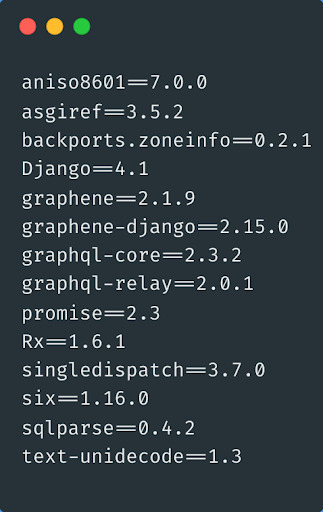
Create django development project and relevant app in your project and configure with settings.py
Create models in model.py for the project in your app.
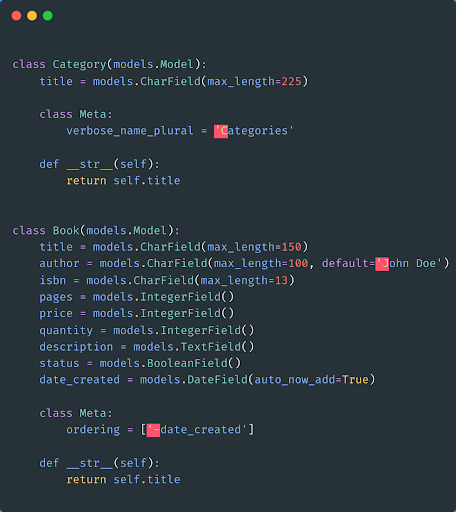
In the above image we create two models Class Category and Book. and added fields for the model Classes.
In the Book model we have added ‘-date_created’ in Meta class for orders according to the date they were created at.
Let’s register models in the app/admin.py file
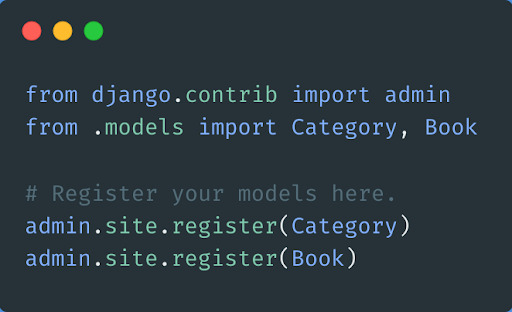
Now run migrations to add our model in the database.
python manage.py makemigrations
python manage.py migrate
Once migration is done, run python manage.py runserver if the app is displayed on your browser, then you are on the right track.
Integrating GraphQL into our project
We will integrate GraphQL into our Django project.
Now, Add graphene_django to INSTALLED_APPS in your settings.py file.
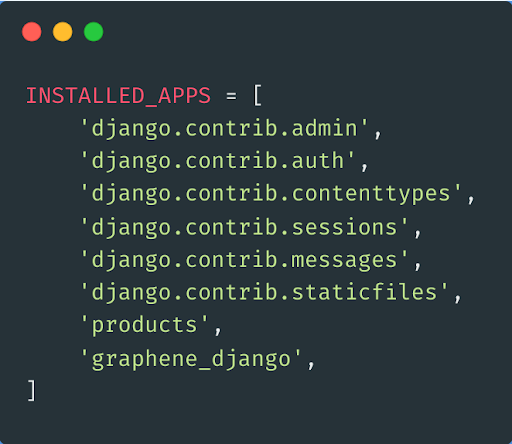
Create schema
GraphQL is a query language with a powerful type system that can be used to define an API’s data structures. The GraphQL Schema is used to represent this information.
A schema is a contract between the client and the server that describes how the client can acquire the database.
You’ll need to add a Schema, Object Type and view function that receives the GraphQL queries to be able to perform GraphQL queries in your web application.
Let’s define our schema in the app directory. We’ll create a file called schema.py.
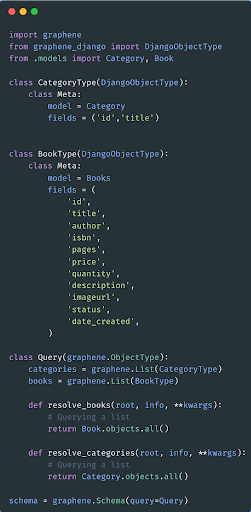
Add above image code in schema.py file.
We create schema for our two models (book and category). CategoryType and BookType is schema.
We also included DjangoObjectType: which uses GraphQL to display all fields on a model.
In ‘graphene.List’ List is object type we can use (nonNull, String, Enum)
class Query: inherits from ‘graphene.ObjectType’ and provides the setting for our graphql queries.
resolve_category , resolve_books are used to open up categories, books querysets. These methods take two parameters (root and info).
graphene.Schema: this query brings in data from our type(database).
Add GraphQL to URL
The only endpoint/API accessible to the client while working with GraphQL is /graphql. This is the only endpoint where clients can send requests and change data. In comparison to REST, we have fewer endpoints to manage.
Add graphql url in project’s urls.py file.
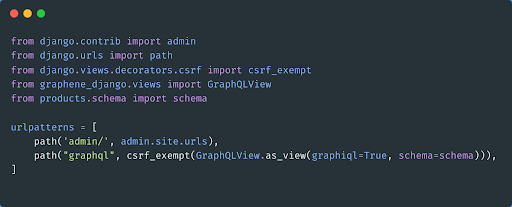
The url contains our endpoint, where our GraphQL communications will be made.
We imported GraphQLView which is a unique view provided by graphene_django which will be executed when GraphQL url is called.
We added a url called “ graphql ”. Then we set graphiql=True which will enable us to use graphiql (GraphQL IDE).
Originally published by: https://www.inexture.com/django-meets-graphql/
0 notes
Text
Why do we need to optimize Django web application framework apps?

Scaling Django into show to offer your app to thousands of visitors is one of the considerable popular issues that individuals in the Django community ask and request about. I can't even count how many people have asked about it on Facebook groups, StackOverflow, and other discussion forums. Yes, Django rises extremely satisfactorily, and we can notice this in use matters like BitBucket, Quora, Instagram, Disqus, and other benefits that Django uses to benefit millions of proposals from its visitors. Unlike some people who think that this does not come for free out of the box once they start using Django.
To have a robust Django website, you need to follow many different best practices to improve many various aspects of building your Django app. It usually focuses on two main things:
Merge assets and optimize images
Optimize database queries
Django equips you with robust web applications along with Python, while you can additionally optimize your Django performance-based web applications by following these suggestions:
Code optimization
In Python code, if you want to know which part of your code needs to be changed, you need to use a specific tool. The Profiling module allows you to check the effectiveness of your code and functions. There are many Pythons profiling programs to choose from (such as cProfile or line_profiler), as well as some additional tools you may want to use later to visualize the results (such as SnakeViz or KCachegrind).
Load cached template
Loading Django's cached templates is another weapon used for optimization. You can enable Cache Template Loader and save time and bandwidth to carry the same template over time. For example, some templates are used frequently, and they are saved when you enable the Cache Template Loader. You can call these templates directly from memory at any time, so you don't have to go back and forth to the file system. This can help significantly reduce response times and improve application performance. So, it's essential to test Django's performance.
Reduce the number of requests and optimize
You receive a request from the front end to fetch data from the database, convert it, and provide it as a JSON response object. Quite easy. But as per experts, the "get data from database" process takes the longest to complete the request. SQL queries filter databases containing hundreds of thousands of records, which takes time. The smaller the number of requests in your view, the faster your response. The problem is, SQL queries are often used haphazardly in Django because, due to Django's ORM, SQL query writes are mostly limited to one or maybe two rows. But this line of code takes a long time if not optimized.
Here are a few ways to modify your Django SQL query:
Use select_related and prefetch_related when operating with model affinities (one-to-one, many-to-many, foreign keys, etc.).
If possible, use a filter instead of repeating the for a loop.
Save your query set in a variable so you can use the variable later instead of having to rerun this query.
If you need the newest or earliest entry in the query set, use this method instead of going to order_by and then getting the latest query results.
Laziness
Being lazy isn't always bad. Lazy evaluation tools can help you get a significant performance boost... laziness complements caching by slowing calculations down until they need to be executed. Otherwise, there is usually no work, which saves time and effort. It would help if you used constructs like generators and expression generators for Python. There are already some lazy QuerySets in Django. You can create a QuerySet and transfer it for as long as you want, without any activity being recorded in the database until the QuerySet is actually evaluated. Only then will Django start it. Django also offers you the keep lazy() decorator, which modifies the function such that when called with the lazy argument, evaluation is also delayed until needed.
Go asynchronously if possible
Asynchronicity is a time-consuming task that must be done "simultaneously" or in the background in different threads without affecting the overall view. An API with an "email" function is a typical example. Now, if this API were to be run line by line, it would not send the response back to the frontend until after the email was sent, meaning the user would not have access to other parts of the app until the whole process was complete. To solve this, threads or asynchronous functions are used, which are executed on multiple lines.
Enable caching
At this point, it is essential to enable different cache levels. Why? Because it allows you to store data in memory. This means that it can avoid unnecessary operations like recalculation, database queries, etc. And reuse the processed data. Cached boot returns prepared results if necessary - straight from memory. Also, keep in mind that an HTTP cache server must serve all static content. The performance of this part of your Python and Django application is less dependent on the number of incoming requests, and you can scale your project in a more optimized way.
Upgrade to a newer version
Improvements were seen in development. It has always been believed that the newer, the better, and effective, but one should not always miss the more recent version. If your python development company attempting to fetch the latest version of Python or Django, make certain your technique is optimized.
Also, you shouldn't expect much from the latest version because sometimes it can be the other way around. So be more careful when upgrading to a newer version.
Keep your code clean
Keeping your code clean and organized is a great way to make the development process more accessible; it can also directly impact your app's uptime. Here are some considerations I found that relate directly to the effectiveness of the app:
Check for duplicate code. If a piece of code appears twice or more in your code, consider creating a function or method with it.
In principle, a method or function should only be called once per process data item. If you need to use the result, store it in a local variable and use that variable instead.
Avoid unnecessary __init__ processes on your object. If something serious, eg. For example, leave an external request to another method so you can control when it is called.
Look for unused variables and method calls. You can spend time doing methods whose results won't be used. Several code editors can help you verify this.
Reread the Django documentation and find a way to do what you need to do; usually cleaner and faster than other approaches.
0 notes
Text
What are the best ways to improve Django performance?
our app may be different so profile it first, but in my experience an average Django app spends most of the time accessing database. Here's the most typical pain points roughly in the order of potential performance gain per effort spent:
1. Indexes. Make sure you have all the right indexes in place. It's very easy to miss them when evolving schema manually.
2. Generic relationships. Never ever use them unless you are operating very small datasets.
3. Use select_related: http://docs.djangoproject.com/en/dev/ref/models/querysets/#select-related . It's very easy to skip, but it often makes a tremendous difference.
4. Cache template fragments that cause database access. But make sure you understand what you are doing and invalidate your caches at appropriate times.
5. Reuse query results within a single request. In a large app, you may find yourself recreating essentially similar querysets in different places. Django will execute a new query for each new queryset. Sometimes this gets costly.
Also, conventional wisdom says that a typical webapp spends most of its time waiting on i/o, but I noticed (and later seen The Onion dev team reporting the same) that Django ORM is pretty taxing on the CPU when constructing queries, so make sure you have enough of CPU power.
Finally, a generic advice that nevertheless cannot be overstated: do not change anything unless you have confirmed it's slow. Do not preserve your changes unless you have confirmed that they improve performance. An easy but very efficient trick I'm using to profile database access is writing a middleware that outputs the contents of django.db.connection.queries variable to console ordered by execution time and grouped by duplicated queries.
#django performance monitoring#django performance testing#django performance tips#django performance profiling#django performance requests per second#django performance issues#django performance vs java#django performance metrics
0 notes
Link
You can use a custom Manager in a particular model by extending the base Manager class and instantiating your custom Manager in your model. There are two reasons you might want to customize a Manager: to add extra Manager methods, and/or to modify the initial QuerySet the Manager returns. via Pocket
2 notes
·
View notes